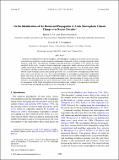On the Identification of the Downward Propagation of Arctic Stratospheric Climate Change over Recent Decades
Author(s)
Solomon, Susan; Thompson, David W. J.; Ivy, Diane J
DownloadIvy-2014-On the Identificatio.pdf (7.723Mb)
PUBLISHER_POLICY
Publisher Policy
Article is made available in accordance with the publisher's policy and may be subject to US copyright law. Please refer to the publisher's site for terms of use.
Terms of use
Metadata
Show full item recordAbstract
Dynamical coupling between the stratospheric and tropospheric circumpolar circulations in the Arctic has been widely documented on month-to-month and interannual time scales, but not on longer time scales. In the Antarctic, both short- and long-term coupling extending from the stratosphere to the surface has been identified. In this study, changes in Arctic temperature, geopotential height, and ozone observed since the satellite era began in 1979 are examined, comparing dynamically quiescent years in which major sudden stratospheric warmings did not occur to all years. It is shown that this approach clarifies the behavior for years without major warmings and that dynamically quiescent years are marked by a strengthening of the Arctic polar vortex over the past 30 years. The associated declines in stratospheric temperatures, geopotential height, and ozone are qualitatively similar to those obtained in the Antarctic (albeit weaker), and propagate downward into the Arctic lowermost stratosphere during late winter and early spring. In sharp contrast to the Antarctic, the strengthening of the Arctic stratospheric vortex appears to originate at a higher altitude, and the propagation to the Arctic troposphere is both very limited and confined to the uppermost troposphere, even when only dynamically quiescent years are considered in the analysis.
Date issued
2014-04Department
Massachusetts Institute of Technology. Department of Earth, Atmospheric, and Planetary SciencesJournal
Journal of Climate
Publisher
American Meteorological Society
Citation
Ivy, Diane J., Susan Solomon, and David W. J. Thompson. “On the Identification of the Downward Propagation of Arctic Stratospheric Climate Change over Recent Decades.” J. Climate 27, no. 8 (April 2014): 2789–2799. © 2014 American Meteorological Society
Version: Final published version
ISSN
0894-8755
1520-0442